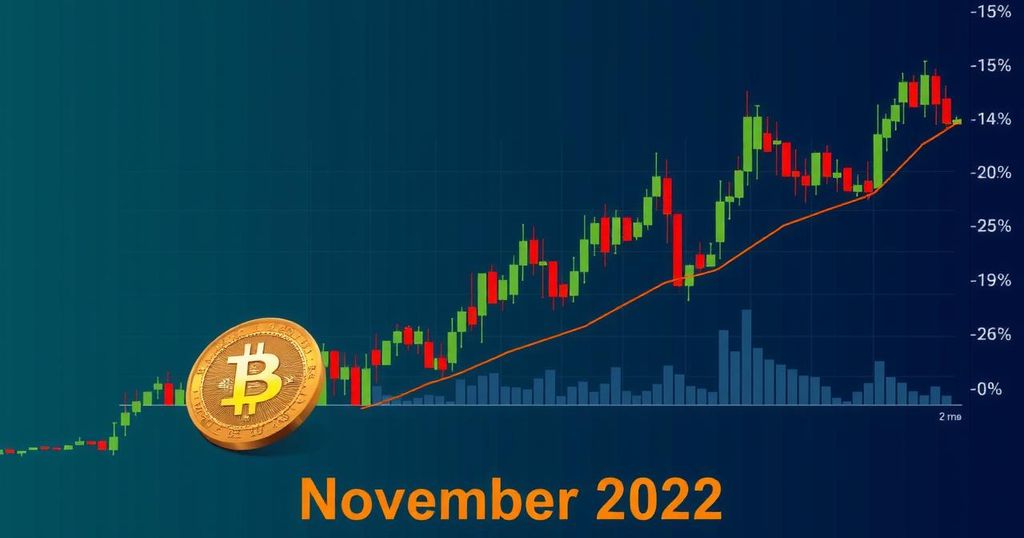Bitcoin Price Faces Challenges Amid Accumulation by Whale Investors
Bitcoin’s current price remains under pressure despite a bullish narrative for October. The cryptocurrency seeks to close consistently above its 200-day Moving Average to reverse midterm bearish sentiments. Whale investors are actively accumulating Bitcoin, contributing to a multi-year low of supply on exchanges, while analysts provide mixed forecasts on Bitcoin’s near-term price potential.
The recent trends in Bitcoin (BTC) prices reveal that the cryptocurrency has not yet fully stabilized despite increasing demand from prominent investors, commonly referred to as whale investors. As of now, Bitcoin is striving to surpass the crucial 200-day Moving Average (MA), which serves as a key indicator for invalidating the prevailing bearish sentiment. Throughout October, a bullish narrative has emerged, potentially allowing Bitcoin to negotiate a return to the uptrend and aiming for an all-time high. Currently, Bitcoin is priced at approximately $60,839, exhibiting a 24-hour volatility of -4.3% and maintaining a market capitalization of $1.20 trillion with a 24-hour trading volume of $53.15 billion. Following a bullish close in September, Bitcoin is attempting to reclaim the 200-day MA as a support level despite experiencing a drop from around $65.6K to $63.2K earlier in the week. Speculation about a positive outlook for the fourth quarter has led to increased volatility in Bitcoin prices; this is compounded by the impact of the Federal Reserve’s recent rate cuts amid the forthcoming 2024 elections in the United States. It is also anticipated that Bitcoin prices may begin to mirror the upward trajectory of gold prices as the market seeks price discovery. Well-known cryptocurrency analyst PlanB suggested that Bitcoin is on track for a new all-time high, particularly after consolidating between $60K and $70K over the past several months. Historically, the fourth quarter has proven favorable for Bitcoin following September’s performance. However, cautionary advice has come from analysts such as Peter Brandt, warning that traders should be wary of additional selloffs unless Bitcoin can maintain consistent closing values above the July peak of around $69.9K. Furthermore, Bitcoin has been encumbered by a macro falling trend since March, displaying a pattern of lower lows and lower highs on the weekly timeframe. From a technical analysis perspective, the four-hour chart indicates a potential selloff in the near term prior to a macro reversal expected by year-end. Should bearish sentiment persist, Bitcoin could experience a retracement to the support levels between $52K and $54K. In terms of market dynamics, data analytics from Coinglass indicates a significant decrease in Bitcoin supply on centralized exchanges, which has shrunk by over 10,000 units within the past week, reaching a multi-year low. This contraction in supply highlights a rising demand primarily driven by US spot Bitcoin exchange-traded funds (ETFs) and heavy accumulation by whale investors. Notably, in the last month alone, US spot Bitcoin ETFs, particularly BlackRock’s IBIT, have amassed Bitcoin amounting to over $1.9 billion, with a reported net cash inflow of $61 million on Monday. In addition, companies such as MicroStrategy Inc. have continued their acquisition of Bitcoin, while El Salvador remains committed to purchasing one Bitcoin daily to enrich its crypto reserves.
The cryptocurrency market, particularly Bitcoin, is influenced by various financial indicators and macroeconomic events. The analysis of Bitcoin prices is often predicated on its historical performance and the broader economic environment, which includes Federal Reserve monetary policy decisions and market demand shifts. Significant movements in Bitcoin’s prices often correlate with trader sentiment and institutional investment trends. Additionally, whale investors play a crucial role in the dynamics of Bitcoin’s supply and demand, creating notable impacts on price behavior. In the current climate of heightened interest in cryptocurrencies, Bitcoin’s performance is continually scrutinized. Analysts often provide insights into price movements based on patterns, trends, and external factors, thereby shaping investor expectations and decision-making processes regarding Bitcoin.
In summary, Bitcoin’s price journey remains uncertain, with a struggle to maintain momentum amidst bearish sentiments. The pivotal 200-day Moving Average presents a crucial threshold for further movement towards a bullish outlook. Whale investors continue to exert significant influence on the market, evidenced by their persistent accumulation tactics, while Bitcoin’s volatility and potential retracement strategies warrant close monitoring. As the economic climate shifts, Bitcoin’s trajectory will likely depend on both macroeconomic factors and market behavior leading into the pivotal fourth quarter.
Original Source: www.coinspeaker.com







Post Comment